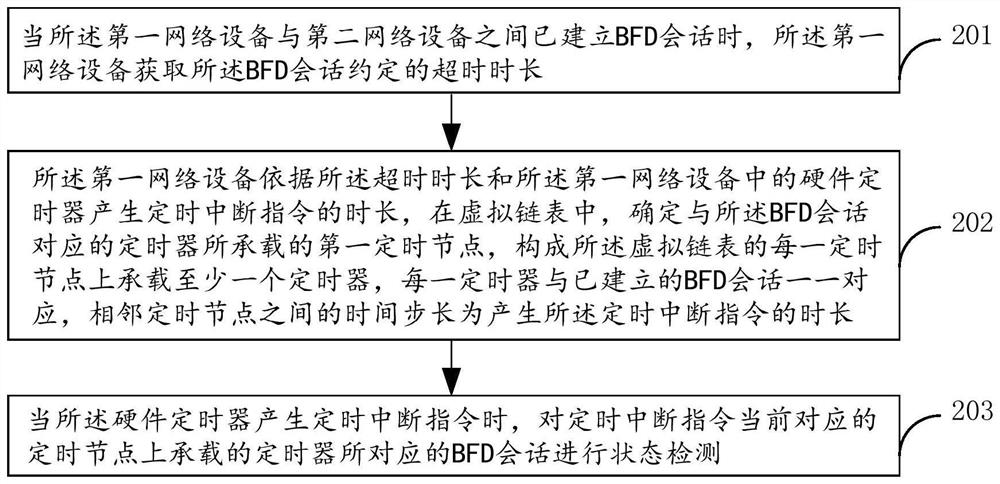Method and Processor for Detecting Bidirectional Forwarding Path Detecting Session State
A processor and forwarding core technology, applied in the transmission system, electrical components, etc., can solve the problem of low efficiency of BFD session state detection, achieve the effect of reducing resources and improving detection efficiency
- Summary
- Abstract
- Description
- Claims
- Application Information
AI Technical Summary
Problems solved by technology
Method used
Image
Examples
Embodiment 1
[0091] figure 1 It is a schematic diagram of the structure of the processor provided by the embodiment of the present application. The processor is in the first network device, such as figure 1 As shown, the processor includes: a control core 11 and a forwarding core 12; wherein,
[0092] The control core 11 is configured to obtain a timeout duration agreed upon by the BFD session when a BFD session has been established between the first network device and the second network device, and output the timeout duration to the forwarding core 12;
[0093] In the embodiment of the present application, in the case where the network device has multi-core CPUs, one of the multi-core CPUs is used as the BFD control core to run the protocol stack and maintain the BFD session state. Some other CPUs in the multi-core CPU are used as BFD forwarding cores to detect the sending and receiving of BFD packets.
[0094]In this way, a multi-core CPU is used to form multiple BFD forwarding cores ...
Embodiment 2
[0132] figure 2 It is a schematic flow chart of the method for detecting the state of the bidirectional forwarding path detection session provided by the embodiment of the present application. The method is applied to a first network device, such as figure 2 As shown, the process includes:
[0133] Step 201, when a BFD session has been established between the first network device and the second network device, the first network device obtains the timeout duration agreed upon by the BFD session;
[0134] In this embodiment of the present application, when the first network device detects the BFD session negotiated and established with the second network device, it acquires the timeout period agreed upon by the negotiated BFD session.
[0135] Step 202, the first network device determines the duration of the timer interrupt command corresponding to the BFD session in the virtual linked list according to the timeout duration and the duration of the hardware timer in the first...
Embodiment 3
[0154] image 3 for figure 2 One of the sub-step flowcharts of step 201 shown. Such as image 3 As shown, the process includes:
[0155] Step 301: When a BFD session has been established between the first network device and the second network device, the BFD control core of the first network device obtains the session information of the BFD session, and constructs the BFD session according to the session information. The session entry of the BFD session, the session entry includes source network equipment information, destination network equipment information and timeout duration;
[0156] In the embodiment of the present application, for the situation where the network device has a multi-core CPU, once the BFD session is established, the format and content of the subsequent periodically sent BFD packets are fixed. Therefore, as an optional embodiment, the maintenance of the BFD session state (BFD session negotiation, UP / DOWN transition processing) and the sending and rec...
PUM
 Login to View More
Login to View More Abstract
Description
Claims
Application Information
 Login to View More
Login to View More - R&D
- Intellectual Property
- Life Sciences
- Materials
- Tech Scout
- Unparalleled Data Quality
- Higher Quality Content
- 60% Fewer Hallucinations
Browse by: Latest US Patents, China's latest patents, Technical Efficacy Thesaurus, Application Domain, Technology Topic, Popular Technical Reports.
© 2025 PatSnap. All rights reserved.Legal|Privacy policy|Modern Slavery Act Transparency Statement|Sitemap|About US| Contact US: help@patsnap.com



